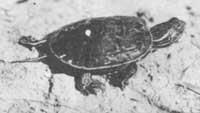Cold turtles
1989/05/01 Elhuyar Zientzia Iturria: Elhuyar aldizkaria
It is known that animals deny or hibernate to combat the red winter. There are turtles that take further adaptation to the cold, freeze. Knowing how these turtles survive after freezing to facilitate human organ transplants can be very useful.
The turtles of the genus Chrysemys picta marginata put their eggs in shallow holes in summer. The young are born in autumn. Instead of the offspring going outside, they deepen the holes and remain until spring.

In these holes the winter temperature reaches -8ºC. Half of the turtle body water is frozen. When the heat comes, the heartbeats begin, then they begin to breathe and finally begin to move. Their behavior becomes completely normal.
When animal cells freeze they contract, so they are exploited and destroyed. This does not happen in these turtles. As has been observed, the cells of these turtles contain abnormal concentrations of glucose, glycerol and taurine. These substances largely prevent cell contraction.
The other problem of freezing is anorexia. When the blood stops moving, oxygen does not reach the cells and the supply is interrupted. Tissues can work without oxygen, but alternative anaerobic metabolism requires large amounts of glucose. The lactate resulting from glucose metabolism has been found in frozen turtles.

Gai honi buruzko eduki gehiago
Elhuyarrek garatutako teknologia





